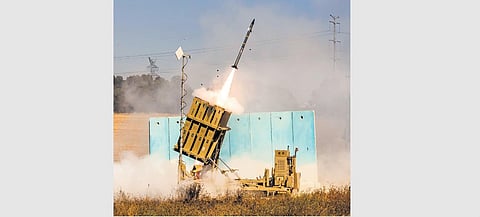

Hundreds of Hamas fighters swept across the Gaza border on motorcycles, paragliders and SUVs, even as Hamas launched a blitz with more than 7,000 missiles. This is a border embedded with micro surveillance devices: finely-calibrated subterranean digital sensors of high sensitivity to monitor Hamas’ movements through tunnels; the border terrain under the charge of the well-equipped Israeli Ground Forces; and the air protected by the celebrated Iron Dome system, which has formed an antimissile carapace over Israel for twelve years now.
But all this came to nought. The Dome didn’t work. The Gaza barrier was infiltrated. Intelligence and surveillance failed. The Israeli Defense Forces (IDF) were caught by surprise. Israel’s much-vaunted security and microsurveillance creds are in the dust. Israel is no longer the most securitised country in the world. That boast is toast.
Most gallingly, it happened in the full public glare that’s so detested by the shadowy Shin Bet (internal security service), Mossad (foreign intelligence service) and Aman (military intelligence)—the capabilities of all of which collapsed in unison.
The long ripples of this failure will be as international as domestic. The indications are that many countries contemplating investing in various versions of Israeli missile interceptor systems—including Germany, the Czech Republic, Finland, and the US—are doing a rethink about installing any component of the Dome system.
The Iron Dome’s inadequacy will also hit the US, which has so far spent upwards of $1.5 billion on the programme and related research, and manufactures roughly 75 percent of the Tamir missile interceptor’s components. In August 2020, Israeli Rafael and American Raytheon formed a joint venture to produce Dome interceptors in the US. In 2021, the US bought two Dome systems from Rafael, one of which was operationalised in 2022. Already, there is opposition from within the senior US military establishment, with arguments that the Dome cannot be integrated into the US Army’s “future air defense brain”, the integrated air and missile defence battle command system.
In September 2021, Israeli forces announced the completion of a 65-km, $1.1-billion, 20-ft tall barrier on the Gaza-Israel border—a ‘smart wall’ embedded with radar systems, high-res cameras, hypersensitive underground sensors, and other imperatives of electronic surveillance. Yet, all it took for Hamas fighters to break through and gain open access to Fortress Israel was bulldozers and wire-clippers.
As far back as 2014, in a report titled The Deadly Rocket Arsenal of Hamas, the IDF had claimed, while launching Operation Protective Edge, “terrorist organisations in the Gaza Strip currently possess around 10,000 rockets including long-range missiles such as the [Syrian-made] M-302”, whose 100-km range is well beyond the 70-km interception capabilities of the Israeli Tamir.
But this was mostly hype. Since 2001, when it began artillery strikes against Israel, Hamas’s rocketry has been defined by the Qassam missile, a simple, homemade device that cannot be tuned to strike specific targets. Most of the missiles that rained down on southern and central Israel, exacting an unconscionable toll of civilians, were inaccurate Qassams. The first early-morning strike of 2,200 Hamas rockets fired over 20 minutes overwhelmed the Iron Dome by their sheer numbers, despite the Dome having tracking radar and rapid-action batteries of Tamir interceptor missiles. This left the skies open for the rest of the missiles.
The IDF boasts that the Iron Dome “was first used in Operation Pillar of Defense in 2012, where over 400 rockets were intercepted”. The website Missile Threat reported, “Near the end of the 2021 Israel-Palestine conflict, … analyses claim the Iron Dome had intercepted 1,428 missiles out of 1,500 rockets approaching populated areas, achieving a 95 percent success rate”.
According to the IDF’s website, “In the latest operation, Operation Shield and Arrow in May 2023 … of the 1,469 Gazan rockets which were launched, only 1,139 rockets managed to cross into Israeli territory. The Iron Dome successfully intercepted 437 rockets, which is a 95.6 percent success rate of all interceptions.”
There are ten Iron Dome batteries across Israel, each with three launchers for twenty interceptor missiles. All of them in southern and central Israel were active, and, by all accounts, took out most of their targets. But Hamas did not only descend with an avalanche of rockets: they also took to the skies with agile paragliders, which were used, in all likelihood, for a combination of spotting, videographing for record and social media, and dropping explosives.
There are fundamental lessons to be relearnt from this low-tech Hamas takedown of the most sophisticated, high-tech national security system on the planet.First, that swarm (or saturation) attacks can defeat the best-laid plans of mice and men. Examples of swarming are evident throughout the history of conflict, from, as a RAND study, Swarming and the Future of Conflict, points out, “the ancient Parthians to the mediaeval Mongols”. This study also proposes the creation of a newly energised military doctrine: ‘BattleSwarm’.
In February 2023, New Scientist wrote about a “new Pentagon project [that] envisages automated, coordinated attacks by swarms of many types of drones that operate in the air, on the ground and in the water”. It is under the aegis of the Autonomous Multi-domain Adaptive Swarm-of-Swarms.
Hamas swarmed Israel. It employed an age-old military tactic—fusillades of arrows and full-tilt charges by war-horses—to overwhelm a new-age strategy. Presaging the future of warfare, swarm attacks by cheaply assembled and disposable drones, it brought the past and the future into the present.
Tellingly, Israel has decided to copy swarming-by-soldiers: it has summoned 300,000 reservists—who train one month a year with the army and return to peaceful civilian lives for the other eleven—to bulk up its armed forces to do a boots-on-the-ground razzia of Gaza.
Kajal Basu
Veteran journalist
(kajalrbasu@gmail.com)